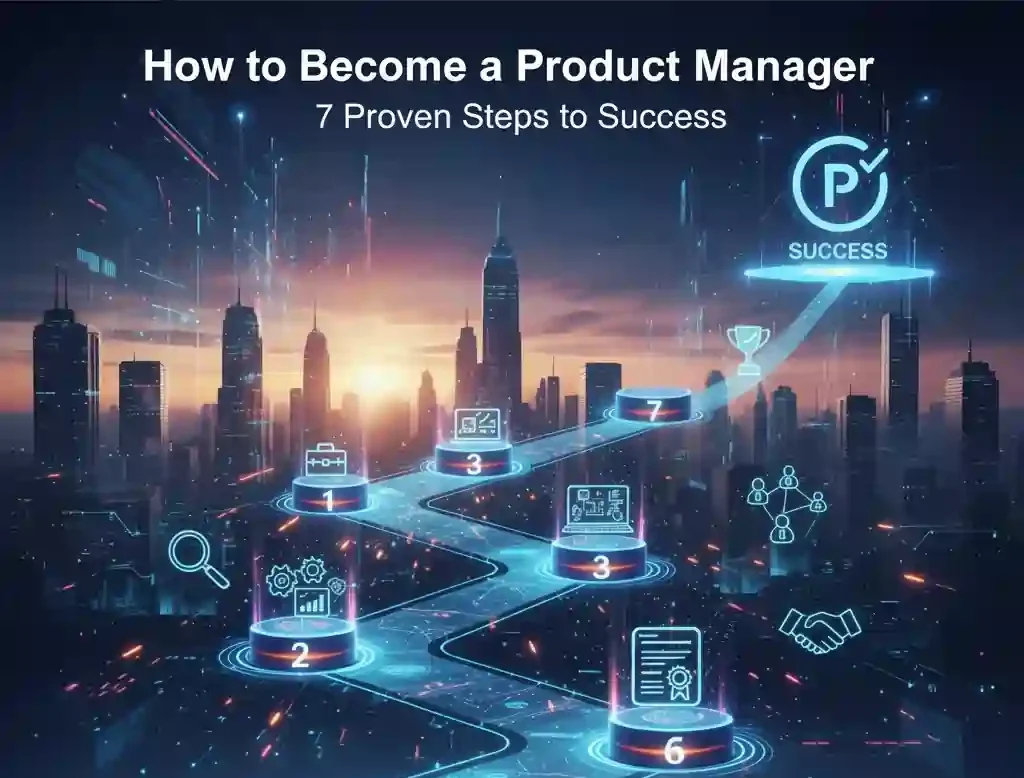Product management is one of the most exciting and impactful roles in tech. It’s where strategy meets execution, and vision turns into reality. But how do you break into this dynamic field? The product manager career path isn’t a straight line; it’s a journey that requires a blend of skills, experience, and grit. Whether you’re transitioning from another role or starting fresh, this guide will walk you through seven actionable steps to become a product manager, backed by real-world insights, stats, and tips to help you stand out.
Table of Contents
Why Choose a Product Manager Career Path?
Product managers (PMs) are the glue that holds teams together, driving the creation of products that solve real problems. According to Glassdoor, product management ranks among the top 10 most in-demand jobs in 2025, with median salaries in the U.S. ranging from $100,000 to $150,000 annually, depending on experience and location. The role is appealing because it combines creativity, problem-solving, and leadership, offering a front-row seat to innovation.
But it’s not all glamour. PMs juggle competing priorities, manage cross-functional teams, and face high expectations. So, what does it take to succeed? Let’s dive into the steps to master the product manager career path.
Step 1: Understand the Product Manager Role
Before you commit to becoming a product manager, you need to know what the role entails. A product manager is responsible for the strategy, roadmap, and success of a product. They act as the voice of the customer, align stakeholders, and ensure the product delivers value.
Key Responsibilities of a Product Manager:
Defining the product vision: Translate customer needs into a clear strategy.
Prioritizing features: Decide what gets built and when, using frameworks like RICE or MoSCoW.
Collaborating with teams: Work with engineering, design, and marketing to execute the roadmap.
Analyzing data: Use metrics to measure success and guide decisions.
Managing stakeholders: Balance input from executives, customers, and team members.
Case Study: At Airbnb, PMs played a pivotal role in launching the “Experiences” feature by identifying a gap in the market for unique, host-led activities. This required deep customer research, iterative testing, and tight collaboration with engineering teams.
Actionable Tip: Shadow a product manager or attend industry events to see the role in action. Platforms like LinkedIn can connect you with PMs for informational interviews.
Step 2: Build Core Product Management Skills
The product manager role demands a versatile skill set. According to a 2024 Product School survey, the top skills hiring managers look for include:
Strategic thinking (82% of employers prioritize this).
Communication (78% value clear articulation of ideas).
Technical knowledge (65% expect basic understanding of tech stacks).
Data analysis (60% want proficiency in tools like Google Analytics or Mixpanel).
Must-Have Product Management Skills:
Customer empathy: Understand user pain points through surveys, interviews, and feedback.
Prioritization frameworks: Learn tools like Kanban, Scrum, or the Eisenhower Matrix.
Basic technical literacy: Know enough about APIs, databases, or UX design to communicate with engineers and designers.
Storytelling: Craft compelling narratives to pitch ideas to stakeholders.
Real-World Example: When Spotify launched its “Discover Weekly” playlist, PMs used data analysis to understand user listening habits, then collaborated with data scientists to build a personalized algorithm. This feature now drives 2.3 billion hours of listening annually.
Actionable Tip: Take free courses on platforms like Coursera or Udemy to learn product management skills like Agile methodologies or user research. Practice mock prioritization exercises to sharpen your decision-making.
Step 3: Gain Relevant Experience
You don’t need a PM title to start building experience. Many successful PMs transition from roles like marketing, engineering, or customer success. According to McKinsey, 40% of PMs in 2025 come from non-traditional backgrounds.
Ways to Gain Experience:
Side projects: Build an app, website, or feature to showcase your ability to manage a product lifecycle.
Internal transitions: Volunteer for cross-functional projects at your current job to work with product teams.
Freelance or internships: Take on small PM gigs through platforms like Upwork or internships at startups.
Case Study: Sarah, a former marketing analyst, transitioned to a PM role at a SaaS company by leading a customer feedback initiative. She used her data skills to prioritize features, earning her a junior PM role within a year.
Actionable Tip: Create a portfolio showcasing projects where you solved a problem, defined a strategy, or collaborated with others. Include metrics to demonstrate impact (e.g., “Increased user retention by 15%”).
Step 4: Master the Product Management Roadmap
A product management roadmap is your blueprint for success. It outlines the product’s vision, goals, and milestones. Learning to create and manage one is critical.
How to Build a Roadmap:
Set clear goals: Align with business objectives (e.g., increase revenue by 10%).
Gather input: Collect feedback from customers, stakeholders, and teams.
Prioritize ruthlessly: Use frameworks like Weighted Scoring to focus on high-impact features.
Communicate visually: Use tools like Jira, Trello, or Asana to share the roadmap.
Iterate often: Update based on user feedback and market changes.
Real-World Example: At Slack, PMs used a roadmap to prioritize integrations with tools like Google Drive, which boosted user adoption by 20% in six months.
Actionable Tip: Practice creating a mock roadmap for a hypothetical product (e.g., a fitness app). Share it with a mentor or peer for feedback.
Step 5: Get Certified (But Don’t Over-Rely on It)
Certifications can signal your commitment, but they’re not a golden ticket. A 2023 Product Management HQ study found that 60% of hiring managers value experience over certifications, but credentials can help you stand out.
Top Certifications:
Certified Scrum Product Owner (CSPO): Focuses on Agile and Scrum.
Pragmatic Institute Certification: Covers product lifecycle management.
Product School’s Product Management Certification (PMC): Offers practical, hands-on training.
Actionable Tip: If you’re new to the field, start with a free or low-cost course like Google’s Product Management Certificate. Pair it with real-world projects to show applied knowledge.
Step 6: Network and Learn from the Community
The product management community is vibrant and supportive. Joining it can open doors to mentorship, job opportunities, and insights.
Ways to Connect:
Online communities: Join Discord or Slack groups like Product School or Mind the Product.
Events and conferences: Attend events like ProductCon or local PM meetups.
Social platforms: Engage with PMs on LinkedIn or X by sharing insights or asking questions.
Real-World Example: John, an aspiring PM, landed his first role at a fintech startup after connecting with a senior PM on LinkedIn. Their coffee chat led to a referral.
Actionable Tip: Follow PM influencers like Shreyas Doshi or Lenny Rachitsky on X for daily insights. Comment thoughtfully on their posts to build visibility.
Step 7: Nail the Interview and Land the Job
The PM interview tests your ability to think strategically, solve problems, and communicate clearly. According to Lewis C. Lin, author of Decode and Conquer, 70% of PM interview questions focus on product sense, execution, and leadership.
Common Interview Questions:
Product sense: “How would you improve [popular product]?”
Execution: “How do you prioritize features for a new app?”
Leadership: “Tell me about a time you resolved a conflict between stakeholders.”
How to Prepare:
Practice case studies: Use frameworks like STAR (Situation, Task, Action, Result) to structure responses.
Mock interviews: Partner with a friend or use platforms like Interviewing.io.
Know the company: Research their products, competitors, and challenges.
Case Study: During a Google PM interview, a candidate was asked to design a feature for Google Maps. By focusing on user pain points (e.g., offline navigation) and proposing a clear solution, they impressed the panel and got the job.
Actionable Tip: Create a “brag sheet” of your achievements, emphasizing metrics and impact. Practice explaining them concisely.
Challenges to Expect on the Product Manager Career Path
The product manager role isn’t all smooth sailing. Here are common hurdles and how to overcome them:
Ambiguity: PMs often work with incomplete information. Embrace uncertainty and use data to guide decisions.
Stakeholder conflicts: Practice active listening and find win-win solutions.
Burnout: Set boundaries and prioritize tasks to avoid overwhelm.
Stat: A 2024 Mind the Product survey found that 45% of PMs report high stress levels due to competing priorities. Combat this by mastering time management and delegation.
FAQs
What qualifications do I need to become a product manager?
You don’t need a specific degree, but a background in business, tech, or design helps. Focus on building product management skills like prioritization, communication, and data analysis through projects or certifications.
How long does it take to become a product manager?
It varies. With relevant experience, you can transition in 6-12 months. Fresh graduates may need 2-3 years of related work before landing a PM role.
Can I become a product manager without a tech background?
Yes! Many PMs come from marketing, sales, or design. Learn basic technical concepts and focus on transferable skills like problem-solving and leadership.
What tools should a product manager master?
Popular tools include Jira, Trello, Figma, Google Analytics, and Tableau. Familiarity with Agile and Scrum frameworks is also essential.
Final Thoughts
The product manager career path is challenging but rewarding. By understanding the role, building essential skills, gaining experience, and networking, you can break into this dynamic field. Stay curious, keep learning, and don’t shy away from challenges. With persistence, you’ll not only become a product manager but thrive as one.
Start small, pick one step from this guide and act on it today. Your journey to becoming a product manager starts now.


















